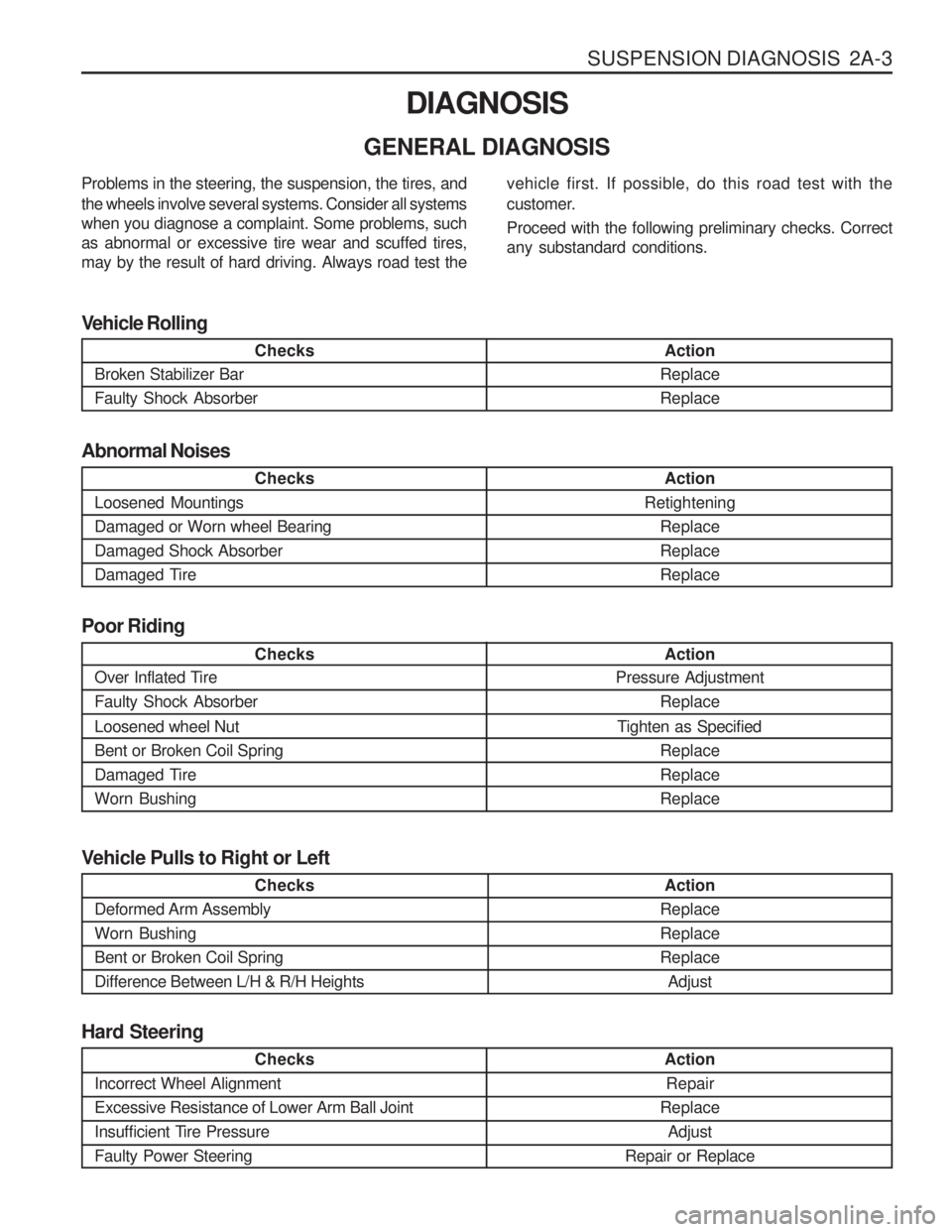Page 700 of 1574

SUSPENSION DIAGNOSIS 2A-3
DIAGNOSIS
GENERAL DIAGNOSIS
Checks
Loosened Mountings Damaged or Worn wheel BearingDamaged Shock Absorber
Damaged Tire Action
Retightening ReplaceReplaceReplace
Abnormal Noises
Checks
Broken Stabilizer Bar Faulty Shock Absorber Action
ReplaceReplace
Vehicle Rolling
Checks
Over Inflated Tire Faulty Shock Absorber Loosened wheel Nut Bent or Broken Coil Spring
Damaged TireWorn Bushing Action
Pressure Adjustment
Replace
Tighten as Specified ReplaceReplaceReplace
Poor Riding
Problems in the steering, the suspension, the tires, and the wheels involve several systems. Consider all systems when you diagnose a complaint. Some problems, suchas abnormal or excessive tire wear and scuffed tires,may by the result of hard driving. Always road test the
vehicle first. If possible, do this road test with the
customer. Proceed with the following preliminary checks. Correct any substandard conditions.
Checks
Incorrect Wheel Alignment Excessive Resistance of Lower Arm Ball Joint
Insufficient Tire PressureFaulty Power Steering
Action Repair
Replace Adjust
Repair or Replace
Hard Steering
Checks
Deformed Arm Assembly Worn BushingBent or Broken Coil SpringDifference Between L/H & R/H Heights Action
ReplaceReplaceReplace Adjust
Vehicle Pulls to Right or Left
Page 808 of 1574
HYDRAULIC BRAKES 4A-11
Adjustment Procedure
1. Pedal HeightNotice If pedal height is not in specified value, loosen the stop lamp nut (B) and adjust the pedal height.
2. Pedal Stroke
Height (A) 150 mm (From the carpet)
Notice If pedal stroke is not in specified value, loosen the stop bolt and lock nut (F) and adjust the pedal stroke.
3. Free Play
Stroke (C) Mando : 138 mm
PBR : 132mm
Notice
To adjust, depress the brake pedal several times until there is no more vacuum left in the vacuum line.
To adjust, loosen the lock nut (D) of the push rod and turn the rod.
Free Play (E) 1 - 4 mm
Inspection Procedure
1. Inspect the wear of bushing.
2. Inspect the warp and bend of brake pedal.
3. Inspect the return spring of brake pedal.
4. Inspect the conductivity when connecting the tester to the stop lamp switch connector.
Page 810 of 1574
HYDRAULIC BRAKES 4A-13
Construction LCRV consists of sensing part and hydraulic control part.
1. Sensing PartIt detects the changes of vehicle height caused by vehicle load. It consists of load sensing spring and control leverwhich change according to vehicle load.
2. Hydraulic Control Part It consists of valve stem devices which controls hydraulicpressure according to load detected by sensing part.
Trouble Shooting Poor Braking Possible Cause
Air in Brake System Poor Adjustment of Sensor SpringDamaged Sensor SpringFluid Leaking from LCRV Remedy
Bleeding Adjust
Replace Replace
Possible Cause
Poor Adjustment of Sensor Spring Internal Fluid Leaking of LCRV Remedy
Adjust
Replace
Abnormal Locking
Page 1294 of 1574
9P-6 DOORS
Adjustment Procedure
1. Adjust the striker in forward / rearward and left / rightdirections. Adjust striker height by increasing / decreasing the shims.
2. Adjust the position of the striker as described above.
3. Adjust the position of the safety hook as described above.
Page 1302 of 1574
9R-4 BODY FRONT END Adjustment Procedure
1. Alignment between hood striker and latch hole.� Loosen the mounting bolt of hood latch slightly and adjust
hood in forward/rearward and left/right directions. Then align the center between hood striker and latch hole.
Notice
Tighten the bolt fully after alignment. Installation Notice
Tightening Toque 13 - 26 Nm
2. Adjusting the height of hood overslam bumper. Unlock the hood and check the clearance between hood and fender by adjusting the hood overslam bumper in left/ right directions.
Normal 20 - 22 Nm
3. Hood Hinge. � Loosen the hood lock bolts.
� Adjust the lock in forward/rearward and left/right
directions, align with the hood striker and adjust the hood height.